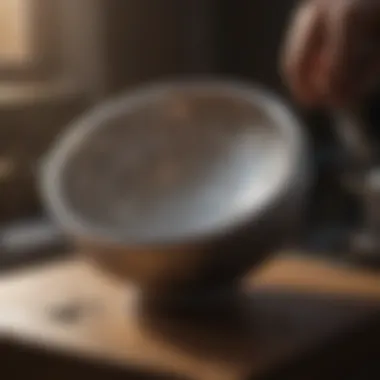Unveiling the Intricacies of Online Silversmithing Courses for Mastering Silver Jewelry Crafting


Rock and Fossil Identification
In the realm of online silversmithing classes, understanding the composition and characteristics of rocks and fossils plays a vital role. Types of rocks and fossils vary greatly, ranging from igneous, sedimentary, to metamorphic rocks, each with unique properties that influence their suitability for jewelry-making. Characteristics to look for include color, hardness, texture, and mineral composition. Utilizing tools such as geology hammers, magnifying glasses, and streak plates enhances the identification process, allowing artisans to differentiate between various rock types and fossils.
Collecting Tips and Techniques
Cultivating the art of collecting is integral to sourcing high-quality materials for silversmithing. Best practices involve conducting thorough research on potential collecting sites, taking into account factors like geological formations and historical mining activities. Locating prime collecting sites often involves exploring remote areas rich in mineral deposits, while adhering to ethical guidelines to preserve natural habitats. Safely extracting specimens requires specialized tools like chisels and rock hammers, ensuring minimal damage to the surrounding environment.
Preservation and Display
Once precious rocks and fossils are gathered, mastering preservation techniques is essential to maintaining their integrity and aesthetic appeal. Proper storage methods, such as storing in padded boxes or display cases, safeguard against damage and deterioration over time. Creative display ideas elevate the visual impact of collections, with options like shadow boxes, glass domes, and custom-designed stands offering a showcase for artisanal creations.
Geological Insights
Delving into geological insights expands artisans' appreciation for the Earth's history and natural processes. Geological formations and processes introduce the intricate science behind rock and fossil formation, shedding light on the evolution of landscapes over millennia. Exploring the historical significance of certain rocks and fossils unveils connections to past civilizations and pivotal moments in Earth's past. Notable discoveries in the field serve as inspirations for aspiring silversmiths, showcasing the beauty and diversity of materials waiting to be transformed into stunning jewelry pieces.
Introduction to Online Silversmithing Classes
When delving into the world of online silversmithing classes, one is met with a treasure trove of opportunities to hone craftsmanship and create stunning silver jewelry pieces. Exploring this realm not only offers a chance to learn new skills but also provides a platform for both beginners and experienced artisans to expand their knowledge in the art of working with silver. This article serves as a valuable resource, guiding individuals through the basics of silversmithing to advanced techniques, catering to a wide range of skill levels and interests.
Benefits of Learning Silversmithing Online
Flexibility of Schedule
Flexibility of schedule stands at the forefront of why online silversmithing classes are a game-changer. Learners can adapt their learning to fit their lifestyle, whether balancing work, family, or other commitments. This flexibility allows students to access lessons at their convenience, promoting a stress-free and tailored learning experience. The ability to choose when to engage with course materials and practice hands-on projects enhances the overall learning journey and encourages a sense of autonomy.
Access to Expert Instructors
Online silversmithing classes grant access to expert instructors from around the globe, offering unrivaled guidance and mentorship. Students benefit from a diverse range of perspectives and techniques, enriching their learning experience. The expertise and knowledge shared by these instructors inspire creativity and foster a deeper understanding of silversmithing, elevating the quality of craftsmanship produced.
Cost-Effectiveness
Cost-effectiveness plays a pivotal role in the appeal of online silversmithing classes. Compared to traditional in-person workshops or courses, online offerings often come at a lower price point. Additionally, learners save on commuting costs, accommodation expenses, and material fees, making it a more economical choice for those looking to delve into the world of silversmithing. Despite the affordability, the quality of education and resources available in online classes remains top-notch, ensuring a fulfilling learning experience.
Overview of Silversmithing Techniques Taught Online
Soldering and Joining
Soldering and joining techniques are fundamental in silversmithing and are meticulously taught in online classes. Students learn how to fuse metal pieces together using heat, creating durable and intricate connections in their jewelry pieces. The art of soldering and joining is crucial in mastering silversmithing, allowing artisans to fabricate complex designs and structures with precision.
Metal Forming
Metal forming is a key aspect of silversmithing that shapes raw materials into exquisite jewelry pieces. Online classes delve into various metal forming techniques, including hammering, rolling, and bending, to mold silver into desired forms. Understanding the properties of metal and honing metal forming skills are essential for crafting visually appealing and structurally sound jewelry items.


Stone Setting
Stone setting adds a touch of elegance and sophistication to silver jewelry, creating stunning pieces that captivate the eye. In online silversmithing classes, students are introduced to different stone setting techniques, such as prong setting, bezel setting, and pave setting. Mastering the art of stone setting enhances the beauty and value of jewelry designs, providing artisans with the expertise to adorn their creations with dazzling gemstones.
Polishing and Finishing
Polishing and finishing techniques are the final steps in the silversmithing process, elevating pieces to a professional standard. Online classes emphasize the importance of proper polishing methods, such as tumbling, buffing, and patination, to achieve a flawless and lustrous surface on silver jewelry. Attention to detail in finishing enhances the overall aesthetics and durability of the final product, ensuring that artisans produce high-quality creations.
Tools and Materials Required for Online Silversmithing Classes
Essential Tools
Essential tools are the foundation of any silversmith's craft, and online classes guide students in assembling the necessary implements for their practice. From hammers and pliers to saws and files, these tools enable artisans to work with precision and efficiency. Understanding the function and maintenance of each tool is essential for success in silversmithing, as they are instrumental in shaping and crafting silver jewelry with accuracy.
Types of Silver Used
The choice of silver used in silversmithing significantly influences the final aesthetic and quality of jewelry pieces. Online classes introduce students to different types of silver, such as sterling silver, fine silver, and silver alloys, each with unique properties and characteristics. By exploring the qualities of various silver materials, artisans can make informed decisions that align with their design vision and desired outcome.
Safety Equipment
Safety is paramount in silversmithing, and online classes prioritize the well-being of students by emphasizing the use of safety equipment. Protective gear, such as goggles, gloves, and aprons, safeguard artisans from hazards associated with metalworking. Understanding proper safety protocols and equipment usage ensures a secure working environment, allowing students to focus on their craft without compromising their health.
Choosing the Right Online Silversmithing Course
In the realm of online silversmithing classes, selecting the right course is pivotal to one's learning journey. The choice of course can significantly impact the development of one's skills and craftsmanship in creating exquisite silver jewelry pieces. For individuals delving into the art of silversmithing, understanding the crucial elements to consider when choosing an online course becomes paramount.
Factors to Consider When Selecting a Course
Skill Level
The skill level required for an online silversmithing course plays a vital role in tailoring the learning experience to individual needs. Beginners benefit from courses that start from the basics, teaching essential techniques step by step. On the other hand, advanced artisans seek courses that offer challenges to enhance their expertise further. Choosing a course that aligns with one's skill level ensures a progressive learning journey tailored to individual proficiency levels.
Curriculum and Course Structure
The curriculum and structure of an online silversmithing course determine the breadth and depth of knowledge one can acquire. A well-organized curriculum covers a range of topics, from fundamental techniques to intricate processes, providing a holistic understanding of silversmithing. Moreover, a structured course ensures a systematic approach to learning, guiding students through each skill with clear objectives and milestones. Understanding the curriculum and course layout beforehand aids in selecting a course best suited to one's learning style and objectives.
Instructor Credentials
The credentials of the course instructors significantly influence the quality of education received. Experienced and reputable instructors bring a wealth of knowledge and insights to the learning experience, offering valuable guidance and mentorship. Their accolades, professional background, and teaching approach contribute to a well-rounded educational experience, shaping students into skilled silversmiths. Choosing a course led by renowned industry experts ensures top-tier instruction and mentorship, enhancing the overall learning outcome.
Student Reviews
Insights from past students through reviews provide invaluable perspectives on the effectiveness and relevance of an online silversmithing course. Positive reviews highlighting impactful learning experiences, hands-on projects, and instructor support indicate a well-received course. Conversely, negative feedback can pinpoint areas of improvement or red flags to consider before enrolling. Considering student reviews enables prospective learners to gain a comprehensive understanding of the course dynamics and community, aiding in making an informed decision when selecting an online silversmithing course.


Progressing Through Online Silversmithing Classes
In the realm of online silversmithing classes, progressing through various stages is crucial for individuals looking to enhance their craftsmanship and expertise in creating exquisite silver jewelry pieces. This section plays a pivotal role in our exploration of online silversmithing, as it sheds light on the journey from foundational knowledge to mastery of advanced techniques. By delving into the progression aspect, learners can grasp a holistic view of their development and evolution within the silversmithing domain.
Developing Fundamental Skills
Practice Projects:
Practice projects hold significant importance in the evolution of silversmithing skills. They provide learners with hands-on experience and a platform to apply theoretical knowledge into practical settings. These projects act as building blocks for mastering techniques, refining craftsmanship, and fostering creativity. Through consistent practice projects, individuals can hone their precision, develop a keen eye for detail, and progress steadily towards creating intricate silver jewelry pieces. The immersive nature of practice projects enhances skill acquisition and instills confidence in aspiring silversmiths.
Understanding Silver Alloys:
Understanding the intricate world of silver alloys is fundamental for any silversmith. It involves grasping the composition, properties, and characteristics of different silver alloys, which directly impact the final outcomes of jewelry pieces. Proficiency in identifying and working with various silver alloys enables artisans to create jewelry pieces with desired attributes such as durability, shine, and malleability. A deep understanding of silver alloys empowers silversmiths to make informed decisions during the jewelry-making process, ensuring high-quality craftsmanship.
Tool Proficiency:
Mastering the use of silversmithing tools is paramount for artisans seeking excellence in their craft. Tool proficiency encompasses efficiency in handling tools, understanding their functions, and leveraging them to achieve precision and finesse in jewelry making. By honing tool proficiency, silversmiths can expedite their workflow, improve the quality of their creations, and explore innovative techniques with confidence. A high level of competency in utilizing tools elevates the overall craftsmanship and sets the foundation for seamless execution of intricate designs.
Advanced Techniques and Projects
Filigree Work:
Filigree work stands out as a sophisticated technique that adds a touch of elegance to silver jewelry pieces. It involves intricate wirework to create delicate patterns and designs, showcasing a blend of artistry and precision. Filigree work allows artisans to craft intricate detailing, intricate latticework, and filigree motifs, showcasing their dexterity and creativity. The art of filigree work expands artistic horizons, enabling silversmiths to produce unique and ornate jewelry pieces that resonate with sophistication and charm.
Chasing and Repoussé:
Chasing and repoussé techniques offer silversmiths the ability to sculpt and shape metal, creating dynamic three-dimensional textures and forms. These techniques involve hammering and manipulating metal to achieve intricate relief designs and decorative elements. Chasing involves working from the front to create raised patterns, while repoussé involves pushing the metal from the back to form raised designs. Mastery of chasing and repoussé opens doors to limitless creative possibilities, enabling artisans to imbue their creations with depth, movement, and intricate detailing.
Creating Hollowware:
Creating hollowware presents a creative challenge for silversmiths, requiring precision and skill to fabricate hollow forms such as bowls, vases, and vessels. This advanced technique involves shaping metal into hollow structures, often incorporating complex designs and functional elements. Hollowware craftsmanship demands attention to detail, proficiency in metal forming, and a mastery of soldering techniques to ensure structural integrity and aesthetic appeal. By venturing into the realm of creating hollowware, artisans can showcase their technical prowess and artistic expression through sculptural silver objects that merge aesthetics with functionality.
Enhancing your Silversmithing Craftsmanship
Enhancing your silversmithing craftsmanship holds a pivotal role in this article, emphasizing the continuous growth and refinement of skills in creating exquisite silver jewelry pieces. By delving into the realm of creative design and mastering advanced techniques, artisans can elevate their craft to new heights. The significance of enhancing craftsmanship lies in the ability to push boundaries, explore innovative design concepts, and hone technical skills for impeccable jewelry creation.
Exploring Creative Design in Silver Jewelry
Design Inspirations
Design inspirations play a crucial role in the silversmithing process, serving as the foundation for crafting unique and striking jewelry pieces. Drawing inspiration from various sources such as nature, architecture, or even emotions, designers can infuse their creations with depth and character. The key characteristic of design inspirations is their ability to spark creativity and differentiate one's work in a saturated market. By embracing diverse influences, artisans can create jewelry that resonates with clients on a deeper level, setting them apart in the competitive jewelry-making industry.
Incorporating Gemstones


Incorporating gemstones into silver jewelry adds a touch of elegance and sophistication, enhancing the beauty and value of the final piece. Gemstones offer a myriad of colors, textures, and patterns that can elevate the design aesthetic and create eye-catching contrasts. The key characteristic of incorporating gemstones is the ability to create visually captivating jewelry that transcends traditional metalwork. While the inclusion of gemstones adds complexity to the design process, the allure and luxurious appeal they bring to silver jewelry make it a popular choice among discerning jewelry enthusiasts.
Experimenting with Textures
Experimenting with textures in silver jewelry design opens up a world of creative possibilities, allowing artisans to add depth and dimension to their pieces. Textures can range from subtle etchings to bold hammering techniques, providing tactile interest and visual intrigue. The unique feature of experimenting with textures lies in the ability to create dynamic and multifaceted jewelry designs that engage the senses. While challenges such as mastering various texturing methods may arise, the richness and character textures bring to silver jewelry make it a rewarding and popular experimentation choice in this article.
Building a Portfolio and Establishing Your Brand
Photography Tips for Jewelry
Photography plays a crucial role in presenting jewelry pieces in their best light, capturing the nuances of design, texture, and gemstones. Photography tips for jewelry focus on lighting, angles, and composition to showcase pieces effectively in online portfolios or marketing materials. The key characteristic of jewelry photography is its impact on attracting potential customers and conveying the quality and craftsmanship of the artisan's work. By mastering jewelry photography, artists can enhance their online presence, attracting a broader audience and establishing a strong brand identity.
Marketing Your Creations
Effective marketing strategies are essential for showcasing and promoting silver jewelry creations to a wider audience, driving sales and brand visibility. Marketing your creations involves understanding target demographics, leveraging social media platforms, and participating in relevant industry events. The key characteristic of successful marketing lies in communicating the unique selling points of each jewelry piece and establishing an emotional connection with potential buyers. While navigating the competitive jewelry market can present challenges, strategic marketing efforts can elevate an artisan's brand and expand their reach significantly in this article.
Networking in the Jeweler Community
Networking within the jeweler community fosters collaboration, learning opportunities, and exposure to new trends and techniques. Building connections with fellow artisans, suppliers, and industry professionals can lead to valuable partnerships, referrals, and mentorship. The key characteristic of networking in the jeweler community is the camaraderie and support it provides, creating a sense of community and shared passion for the craft. While networking may require stepping out of one's comfort zone, the benefits of forging meaningful relationships and gaining industry insights make it a worthwhile endeavor in growing one's silversmithing journey.
Mastering the Art of Silversmithing
In this article, the section on 'Mastering the Art of Silversmithing' holds paramount importance as it delves into the pinnacle of expertise and knowledge within the realm of silversmithing. For artisans seeking to elevate their craft to a level of mastery, this section serves as a beacon of guidance and inspiration. Mastering the art involves a continuous journey of honing skills, exploring new techniques, and contributing back to the silversmithing community. It encapsulates the essence of lifelong learning and growth in the field of jewelry making.
Continuous Learning and Growth
Attending Workshops and Seminars
Attending workshops and seminars is a pivotal aspect of continuous learning and growth in the silversmithing domain. By partaking in these curated events, artisans have the opportunity to engage with industry experts, learn about the latest trends, and enhance their skill set. The interactive nature of workshops and seminars fosters a dynamic learning environment, encouraging participants to push boundaries and innovate. However, one must carefully select workshops and seminars that align with their artistic goals and technical proficiency to derive maximum benefit.
Exploring New Techniques
Exploration of new techniques is a cornerstone of advancing in the art of silversmithing. By delving into uncharted territories and embracing innovative methods, artisans can expand their creative horizons and imbue their work with fresh perspectives. The process of exploring new techniques entails a sense of experimentation and willingness to step outside one's comfort zone. While it may pose challenges, the rewards often manifest in the form of unique creations and personal growth. Embracing a mindset of curiosity and adaptability is key to harnessing the full potential of exploring new techniques.
Experimenting with Mixed Media
Experimenting with mixed media presents a distinctive avenue for silversmiths to push creative boundaries and infuse diversity into their craftsmanship. By blending silver with complementary materials such as gemstones, glass, or wood, artisans can create visually captivating pieces that exude uniqueness and sophistication. The juxtaposition of different textures and colors adds depth to the final artwork, showcasing the artist's versatility and inventiveness. While experimenting with mixed media requires a meticulous approach and thoughtful design, the outcomes can be exceptionally rewarding, unveiling new dimensions of artistic expression.
Contributing to the Silversmithing Community
Mentoring New Artists
Mentoring new artists is an enriching endeavor that contributes significantly to the nurturing of talent and skills within the silversmithing community. By sharing experiences, offering guidance, and imparting knowledge, seasoned artisans play a vital role in shaping the next generation of jewelry makers. Mentoring fosters a sense of camaraderie and collaboration, creating a supportive network where creativity flourishes and ideas proliferate. While mentoring demands commitment and patience, the gratification derived from witnessing protégés flourish in their craft is truly invaluable.
Collaborating on Projects
Collaborating on projects offers a platform for silversmiths to synergize their strengths, exchange ideas, and co-create pieces that transcend individual visions. Through collaboration, artisans pool their expertise, tap into diverse perspectives, and embark on collective artistic journeys that culminate in harmonious creations. The collaborative process instills a sense of teamwork and camaraderie, fostering a spirit of unity within the silversmithing community. While collaboration may entail compromise and shared decision-making, the outcome often transcends individual capabilities, resulting in impactful pieces that resonate with audiences.
Exhibiting Your Work
Exhibiting one's work serves as a culminating showcase of artistic expression and craftsmanship, allowing silversmiths to share their creations with a wider audience and garner recognition for their talents. By participating in exhibitions, fairs, or shows, artisans have the opportunity to receive feedback, engage with enthusiasts, and forge connections within the art community. The exposure gained through showcasing work not only validates one's skills but also opens doors to new opportunities and collaborations. While exhibiting work entails careful presentation and curation, the experience of seeing one's creations admired and valued by others is a gratifying validation of artistic journey.







